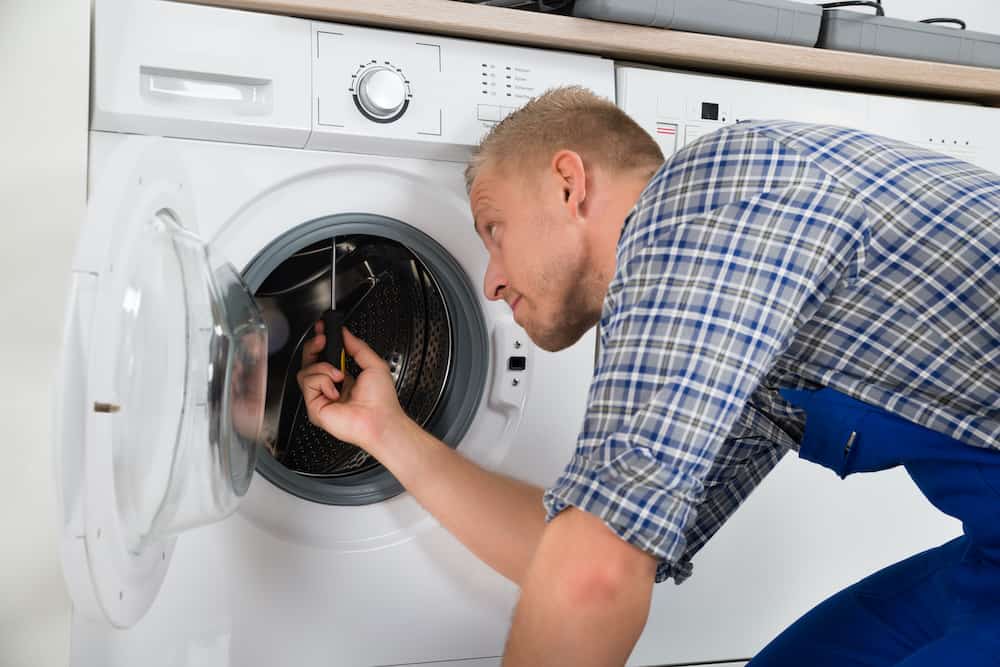
A washing machine’s drain difficulties come into one of two categories: either the water will not drain out of the machine itself, or the water will drain but cannot flow correctly via the drain pipes. These broad concerns might be caused by a variety of particular conditions, and identifying them can be difficult. Some of the issues you can address yourself, while others will almost certainly necessitate a call to an appliance repair expert.
Diagnosing the Problem
First, be sure you read the owner’s handbook for your washing machine. The troubleshooting section may provide you with recommendations for possible causes of drain difficulties. Some new washing machines display error codes that will help you diagnose the problem. If this doesn’t solve the problem, watch your washing machine during one of its drain cycles. As you see the machine in action, one of the following issues is likely to be identified:
- A clog has formed in the rubber drain tube that connects the washing machine to the drain standpipe.
- Objects that restrict the water pump filter or impellers
- A water pump mechanical failure
- Drive belt that is slack or damaged
- The lid switch is broken.
- Drainage system clog
Washer drain clogged
If you hear the washing machine’s pump working but no water is draining, the rubber drain hose flowing from the rear of the machine to the drain standpipe or washtub is most likely clogged with cloth fibres. This can happen after washing goods such as carpets, which can shed a lot of fabric fibres, or if the drain line is squeezed. If the hose becomes blocked, the water cannot be pushed out of the machine.
To check, remove the drain line from the washer and make sure it is clear. Blowing air through the drain hose is an easy technique to ensure that it is clear. If there is nothing impeding the drain tube, the issue is most likely with the washing machine pump. If the hose is damaged or badly kinked, replacing it may enhance the machine’s ability to pump water.
Drain Pump Challenges
If you can hear the pump running but it sounds laboured, a piece of cloth or something material may be clogging the pump mechanism. To fix this, turn off and empty the machine, then remove the washing machine panel to inspect the water pump. The pump itself might be blocked, or the obstruction could be in the corrugated tubing leading to the pump. Most pumps have detachable covers, and inside the pump is a filter screen. If the screen is clogged with debris, cleaning it and reassembling the pump should resolve the issue.
The pump is normally situated on the rear of a top-loading washing machine; in front-loaders, it is usually positioned on the front of the machine, below the door. Rinse the filter screen with water to remove any visible lint. Also, inspect the pump’s impellers to ensure they are clear of obstructions and moving freely. Reassemble the pump and cover panel, then run the machine through its paces.
If the pump is producing no noise at all, and there are no blockages in the pump or drain hose. Your water pump may have failed and will need to be replaced. Normally, this is a job for an appliance repair technician. A knowledgeable homeowner may order the part and conduct the replacement.
Lid Switch Problems
A little plastic switch located just beneath the lid or door of the washing machine detects when the door is closed and allows the machine to function. If this switch fails, the machine may not drain properly. Press the switch by hand while the door is open and the machine is running, and listen for a clicking sound. If you don’t hear it, the switch might need to be replaced.
Drive Belt Problems
A drive belt that goes around pulleys on the bottom of the washing machine motor powers the pump. If this belt is damaged or not tight on the pulleys, the washing machine will drain slowly or not at all. To fix this, you’ll need to flip the machine over on its side and inspect the belt. Homeowners may perform this themselves, but many choose to hire a repairman for this level of work.
Plumbing System Issues
If water is effectively pumped out of the machine but subsequently spills out of the drain stand tube or backs up in the washtub, the issue is most likely a typical drain blockage. Because minute fabric fibres are constantly pumped through the system, drain blockages in the plumbing pipes into which the washing machine empties are typical. Water backs up into the standpipe and spills on the floor as a result of a clogged drain. Usually, clearing the clogged drain will cure the problem.
The washing machine drain hose is around two feet long and connects to the plumbing drain standpipe. (In some machines, the drain line is simply fastened to the edge of a washtub, however this is no longer permissible.) The water is subsequently directed into a drain trap. It’s possible that the clog is in this trap region, or it’s further down the drain line.
First, load the washing machine with water to detect the location of the clog. Set the dial to the spin/drain position and prepare to drain it. Place yourself in such a way that you can view the drain standpipe while still having access to the washer dial. By keeping an eye on the standpipe, you’ll be attempting to determine how long it takes for the water to back up and exit the drain pipe.
Keep in mind that you should be prepared to stop the washing machine from emptying at any time.
- If the washer backs up in a matter of seconds, the blockage is most likely fairly near and may be cleaned with a tiny power drain snake inserted via the standpipe. You might even be able to get rid of it using a little hand-operated snake.
- If the drain takes some time to back up, the blockage is likely to be further down the drainpipe, maybe even past the drain trap. To remove the obstruction, you’ll need to utilise a medium drain snake via a clean-out.
Most folks do not have the drain snakes required to remove these types of clogs. If you opt to do it yourself, they may be leased by the hour from home improvement and tool rental businesses. Behind the washing machine, there is usually a clean-out fitting that may be used to snake out the drain pipes.
For Severe Clogs, Don’t Hesitate to Call a Professional
As with any home plumbing problem, knowing your own DIY boundaries as a homeowner is critical. Don’t aggravate the situation by employing ineffective clog-clearing approaches or attempting to clear your clogged washing machine pipes without the necessary gear or skills. When you realise you’re in over your head, turn to skilled plumbing specialists like Express Sewer & Drain. We’ve been assisting Sacramento residents in keeping their pipes free for many years, and there’s nothing we haven’t seen in that time. Please contact us as soon as possible so that we can begin returning your home’s plumbing to functioning condition.

:max_bytes(150000):strip_icc():format(webp)/washing-machine-wont-drain-2718776-8a553388d53049d0811fd72dc8bbd182.gif)


